Fabrizio Falchi
ISTI CNR, Pisa, Italy
CA3D: Convolutional-Attentional 3D Nets for Efficient Video Activity Recognition on the Edge
May 26, 2025Abstract:In this paper, we introduce a deep learning solution for video activity recognition that leverages an innovative combination of convolutional layers with a linear-complexity attention mechanism. Moreover, we introduce a novel quantization mechanism to further improve the efficiency of our model during both training and inference. Our model maintains a reduced computational cost, while preserving robust learning and generalization capabilities. Our approach addresses the issues related to the high computing requirements of current models, with the goal of achieving competitive accuracy on consumer and edge devices, enabling smart home and smart healthcare applications where efficiency and privacy issues are of concern. We experimentally validate our model on different established and publicly available video activity recognition benchmarks, improving accuracy over alternative models at a competitive computing cost.
CountingDINO: A Training-free Pipeline for Class-Agnostic Counting using Unsupervised Backbones
Apr 23, 2025Abstract:Class-agnostic counting (CAC) aims to estimate the number of objects in images without being restricted to predefined categories. However, while current exemplar-based CAC methods offer flexibility at inference time, they still rely heavily on labeled data for training, which limits scalability and generalization to many downstream use cases. In this paper, we introduce CountingDINO, the first training-free exemplar-based CAC framework that exploits a fully unsupervised feature extractor. Specifically, our approach employs self-supervised vision-only backbones to extract object-aware features, and it eliminates the need for annotated data throughout the entire proposed pipeline. At inference time, we extract latent object prototypes via ROI-Align from DINO features and use them as convolutional kernels to generate similarity maps. These are then transformed into density maps through a simple yet effective normalization scheme. We evaluate our approach on the FSC-147 benchmark, where we outperform a baseline under the same label-free setting. Our method also achieves competitive -- and in some cases superior -- results compared to training-free approaches relying on supervised backbones, as well as several fully supervised state-of-the-art methods. This demonstrates that training-free CAC can be both scalable and competitive. Website: https://lorebianchi98.github.io/CountingDINO/
Semi-Supervised Biomedical Image Segmentation via Diffusion Models and Teacher-Student Co-Training
Apr 02, 2025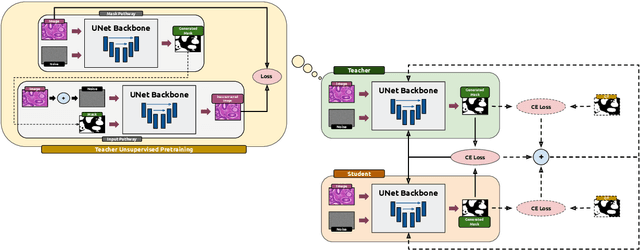
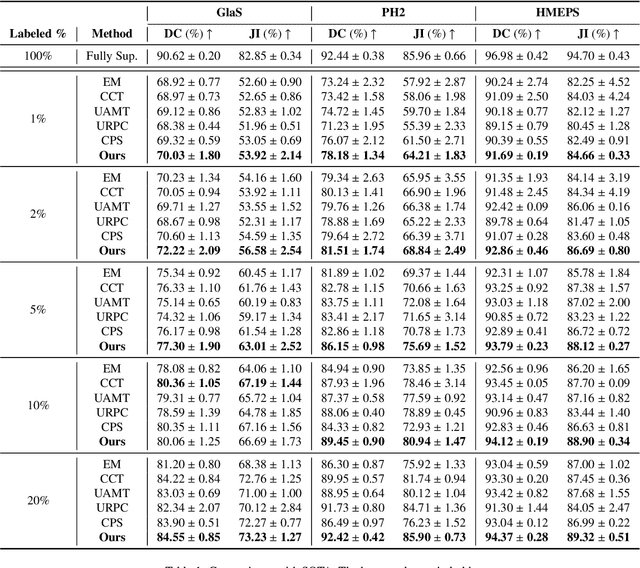
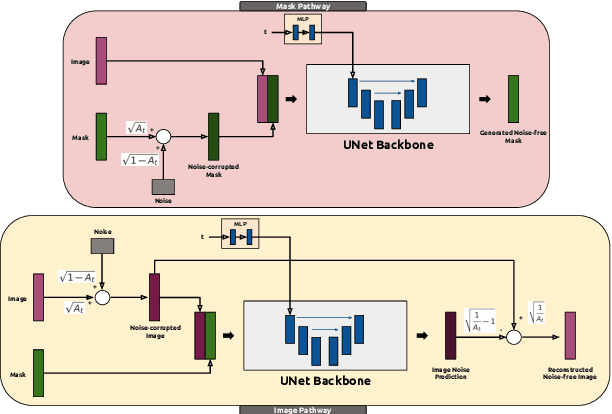
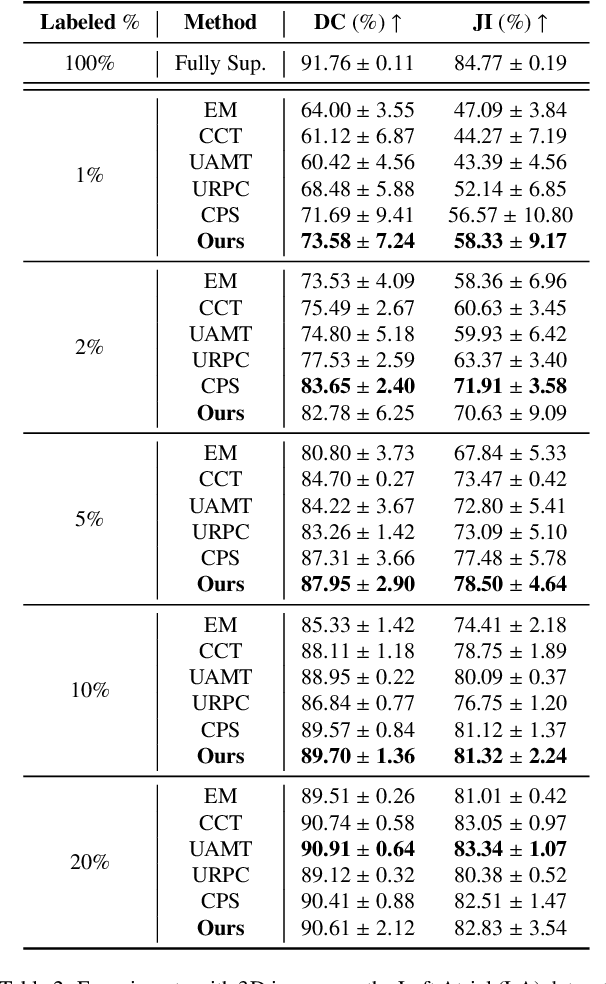
Abstract:Supervised deep learning for semantic segmentation has achieved excellent results in accurately identifying anatomical and pathological structures in medical images. However, it often requires large annotated training datasets, which limits its scalability in clinical settings. To address this challenge, semi-supervised learning is a well-established approach that leverages both labeled and unlabeled data. In this paper, we introduce a novel semi-supervised teacher-student framework for biomedical image segmentation, inspired by the recent success of generative models. Our approach leverages denoising diffusion probabilistic models (DDPMs) to generate segmentation masks by progressively refining noisy inputs conditioned on the corresponding images. The teacher model is first trained in an unsupervised manner using a cycle-consistency constraint based on noise-corrupted image reconstruction, enabling it to generate informative semantic masks. Subsequently, the teacher is integrated into a co-training process with a twin-student network. The student learns from ground-truth labels when available and from teacher-generated pseudo-labels otherwise, while the teacher continuously improves its pseudo-labeling capabilities. Finally, to further enhance performance, we introduce a multi-round pseudo-label generation strategy that iteratively improves the pseudo-labeling process. We evaluate our approach on multiple biomedical imaging benchmarks, spanning multiple imaging modalities and segmentation tasks. Experimental results show that our method consistently outperforms state-of-the-art semi-supervised techniques, highlighting its effectiveness in scenarios with limited annotated data. The code to replicate our experiments can be found at https://github.com/ciampluca/diffusion_semi_supervised_biomedical_image_segmentation
A Survey on Class-Agnostic Counting: Advancements from Reference-Based to Open-World Text-Guided Approaches
Jan 31, 2025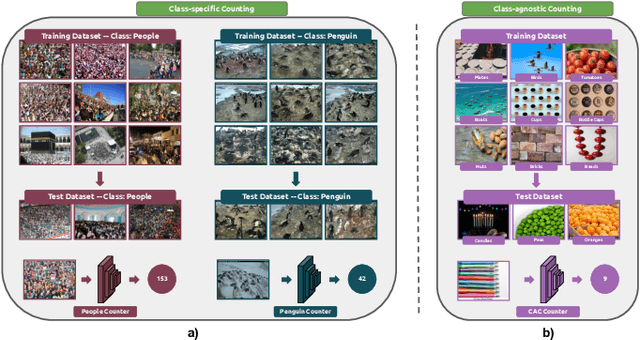
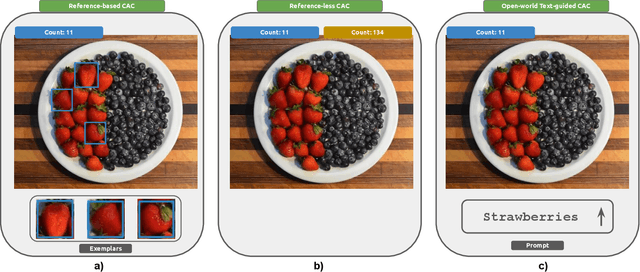


Abstract:Object counting has recently shifted towards class-agnostic counting (CAC), which addresses the challenge of counting objects across arbitrary categories, tackling a critical need in versatile counting systems. While humans effortlessly identify and count objects from diverse categories without prior knowledge, most counting methods remain restricted to enumerating instances of known classes, requiring extensive labeled datasets for training, and struggling under open-vocabulary settings. Conversely, CAC aims to count objects belonging to classes never seen during training, typically operating in a few-shot setting. In this paper, for the first time, we review advancements in CAC methodologies, categorizing them into three paradigms based on how target object classes can be specified: reference-based, reference-less, and open-world text-guided. Reference-based approaches have set performance benchmarks using exemplar-guided mechanisms. Reference-less methods eliminate exemplar dependency by leveraging inherent image patterns. Finally, open-world text-guided methods utilize vision-language models, enabling object class descriptions through textual prompts, representing a flexible and appealing solution. We analyze state-of-the-art techniques and we report their results on existing gold standard benchmarks, comparing their performance and identifying and discussing their strengths and limitations. Persistent challenges -- such as annotation dependency, scalability, and generalization -- are discussed, alongside future directions. We believe this survey serves as a valuable resource for researchers to understand the progressive developments and contributions over time and the current state-of-the-art of CAC, suggesting insights for future directions and challenges to be addressed.
Maybe you are looking for CroQS: Cross-modal Query Suggestion for Text-to-Image Retrieval
Dec 18, 2024



Abstract:Query suggestion, a technique widely adopted in information retrieval, enhances system interactivity and the browsing experience of document collections. In cross-modal retrieval, many works have focused on retrieving relevant items from natural language queries, while few have explored query suggestion solutions. In this work, we address query suggestion in cross-modal retrieval, introducing a novel task that focuses on suggesting minimal textual modifications needed to explore visually consistent subsets of the collection, following the premise of ''Maybe you are looking for''. To facilitate the evaluation and development of methods, we present a tailored benchmark named CroQS. This dataset comprises initial queries, grouped result sets, and human-defined suggested queries for each group. We establish dedicated metrics to rigorously evaluate the performance of various methods on this task, measuring representativeness, cluster specificity, and similarity of the suggested queries to the original ones. Baseline methods from related fields, such as image captioning and content summarization, are adapted for this task to provide reference performance scores. Although relatively far from human performance, our experiments reveal that both LLM-based and captioning-based methods achieve competitive results on CroQS, improving the recall on cluster specificity by more than 115% and representativeness mAP by more than 52% with respect to the initial query. The dataset, the implementation of the baseline methods and the notebooks containing our experiments are available here: https://paciosoft.com/CroQS-benchmark/
Biologically-inspired Semi-supervised Semantic Segmentation for Biomedical Imaging
Dec 04, 2024



Abstract:We propose a novel two-stage semi-supervised learning approach for training downsampling-upsampling semantic segmentation architectures. The first stage does not use backpropagation. Rather, it exploits the bio-inspired Hebbian principle "fire together, wire together" as a local learning rule for updating the weights of both convolutional and transpose-convolutional layers, allowing unsupervised discovery of data features. In the second stage, the model is fine-tuned with standard backpropagation on a small subset of labeled data. We evaluate our methodology through experiments conducted on several widely used biomedical datasets, deeming that this domain is paramount in computer vision and is notably impacted by data scarcity. Results show that our proposed method outperforms SOTA approaches across different levels of label availability. Furthermore, we show that using our unsupervised stage to initialize the SOTA approaches leads to performance improvements. The code to replicate our experiments can be found at: https://github.com/ciampluca/hebbian-medical-image-segmentation
Talking to DINO: Bridging Self-Supervised Vision Backbones with Language for Open-Vocabulary Segmentation
Nov 28, 2024



Abstract:Open-Vocabulary Segmentation (OVS) aims at segmenting images from free-form textual concepts without predefined training classes. While existing vision-language models such as CLIP can generate segmentation masks by leveraging coarse spatial information from Vision Transformers, they face challenges in spatial localization due to their global alignment of image and text features. Conversely, self-supervised visual models like DINO excel in fine-grained visual encoding but lack integration with language. To bridge this gap, we present Talk2DINO, a novel hybrid approach that combines the spatial accuracy of DINOv2 with the language understanding of CLIP. Our approach aligns the textual embeddings of CLIP to the patch-level features of DINOv2 through a learned mapping function without the need to fine-tune the underlying backbones. At training time, we exploit the attention maps of DINOv2 to selectively align local visual patches with textual embeddings. We show that the powerful semantic and localization abilities of Talk2DINO can enhance the segmentation process, resulting in more natural and less noisy segmentations, and that our approach can also effectively distinguish foreground objects from the background. Experimental results demonstrate that Talk2DINO achieves state-of-the-art performance across several unsupervised OVS benchmarks. Source code and models are publicly available at: https://lorebianchi98.github.io/Talk2DINO/.
Exploring Strengths and Weaknesses of Super-Resolution Attack in Deepfake Detection
Oct 05, 2024Abstract:Image manipulation is rapidly evolving, allowing the creation of credible content that can be used to bend reality. Although the results of deepfake detectors are promising, deepfakes can be made even more complicated to detect through adversarial attacks. They aim to further manipulate the image to camouflage deepfakes' artifacts or to insert signals making the image appear pristine. In this paper, we further explore the potential of super-resolution attacks based on different super-resolution techniques and with different scales that can impact the performance of deepfake detectors with more or less intensity. We also evaluated the impact of the attack on more diverse datasets discovering that the super-resolution process is effective in hiding the artifacts introduced by deepfake generation models but fails in hiding the traces contained in fully synthetic images. Finally, we propose some changes to the detectors' training process to improve their robustness to this kind of attack.
Mind the Prompt: A Novel Benchmark for Prompt-based Class-Agnostic Counting
Sep 24, 2024Abstract:Class-agnostic counting (CAC) is a recent task in computer vision that aims to estimate the number of instances of arbitrary object classes never seen during model training. With the recent advancement of robust vision-and-language foundation models, there is a growing interest in prompt-based CAC, where object categories to be counted can be specified using natural language. However, we identify significant limitations in current benchmarks for evaluating this task, which hinder both accurate assessment and the development of more effective solutions. Specifically, we argue that the current evaluation protocols do not measure the ability of the model to understand which object has to be counted. This is due to two main factors: (i) the shortcomings of CAC datasets, which primarily consist of images containing objects from a single class, and (ii) the limitations of current counting performance evaluators, which are based on traditional class-specific counting and focus solely on counting errors. To fill this gap, we introduce the Prompt-Aware Counting (PrACo) benchmark, which comprises two targeted tests, each accompanied by appropriate evaluation metrics. We evaluate state-of-the-art methods and demonstrate that, although some achieve impressive results on standard class-specific counting metrics, they exhibit a significant deficiency in understanding the input prompt, indicating the need for more careful training procedures or revised designs. The code for reproducing our results is available at https://github.com/ciampluca/PrACo.
Joint-Dataset Learning and Cross-Consistent Regularization for Text-to-Motion Retrieval
Jul 02, 2024

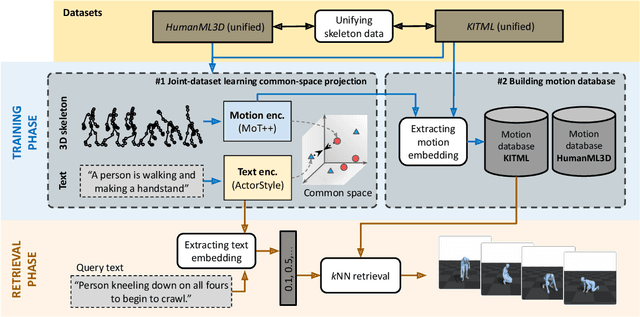

Abstract:Pose-estimation methods enable extracting human motion from common videos in the structured form of 3D skeleton sequences. Despite great application opportunities, effective content-based access to such spatio-temporal motion data is a challenging problem. In this paper, we focus on the recently introduced text-motion retrieval tasks, which aim to search for database motions that are the most relevant to a specified natural-language textual description (text-to-motion) and vice-versa (motion-to-text). Despite recent efforts to explore these promising avenues, a primary challenge remains the insufficient data available to train robust text-motion models effectively. To address this issue, we propose to investigate joint-dataset learning - where we train on multiple text-motion datasets simultaneously - together with the introduction of a Cross-Consistent Contrastive Loss function (CCCL), which regularizes the learned text-motion common space by imposing uni-modal constraints that augment the representation ability of the trained network. To learn a proper motion representation, we also introduce a transformer-based motion encoder, called MoT++, which employs spatio-temporal attention to process sequences of skeleton data. We demonstrate the benefits of the proposed approaches on the widely-used KIT Motion-Language and HumanML3D datasets. We perform detailed experimentation on joint-dataset learning and cross-dataset scenarios, showing the effectiveness of each introduced module in a carefully conducted ablation study and, in turn, pointing out the limitations of state-of-the-art methods.
 Add to Chrome
Add to Chrome Add to Firefox
Add to Firefox Add to Edge
Add to Edge